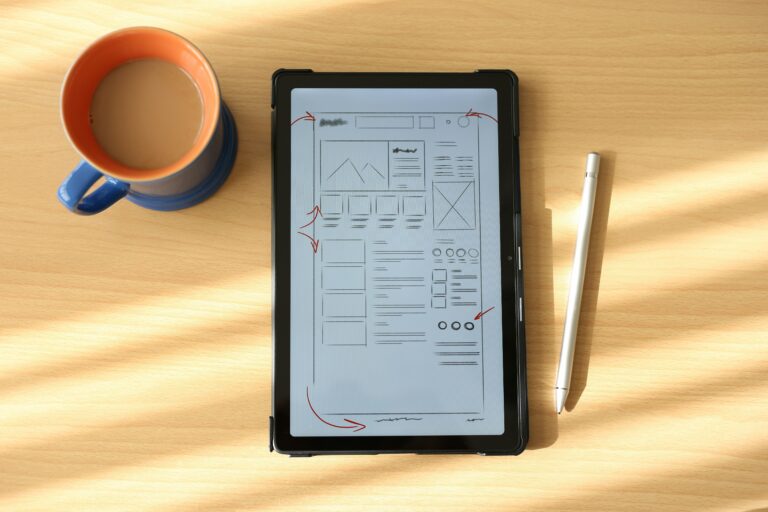Where does a UX Researcher role fit into the UX team?
They report into a UX Manager or UX Lead. They may work alongside a UX Designer depending on the size of the team and its organisational structure.
User Experience Researcher / UX Researcher
This page is written for an existing employee within this role or for someone who would like progress to this position. This guide covers the role, what skills are required, salary expectations and more.
If you’re an employer looking to recruit for this position, please see our product design and UX recruitment services page.
What is a User Experience Researcher?
This role plays a crucial role in the development of products, services, and digital interfaces. They are responsible for understanding the needs, desires, and behaviour of users and use that information to design user-friendly and effective products.
This role involves several key responsibilities, including conducting user research, analysing data, and communicating insights to cross-functional teams. They responsible for conducting user research through various qualitative and quantitative methods, such as surveys, interviews, and usability testing. They analyse the data collected from these methods to gain insights into user behaviour, preferences, and pain points. These insights are used to inform the design and development of products and services.
They are also responsible for communicating their findings and recommendations to cross-functional teams, including Product Managers, Designers, and Developers. They use various tools and techniques, such as personas, journey maps, and usability reports, to communicate their insights effectively. This helps ensure that the entire team is aligned around user needs and that the product exceeds the expectations of the target consumer.
Find out more detail in our blog ‘What is a UX Researcher?’
What type of companies need this role?
Any company that develops digital products can benefit from having this role on their team. This includes technology companies, software companies, e-Commerce businesses, social media platforms, mobile app developers, and more. Any company that aims to provide a positive user experience for their customers needs to have a UX employee on their team.
When does a business need to recruit?
A business should consider hiring for this role when they want to ensure that their digital products are user-friendly, efficient, effective, and satisfying to use. This includes when they are developing new products or redesigning existing ones. This employee can help to identify areas where the product can be improved and provide insights into how users are interacting with the product.
It is also beneficial to hire for this position early in the product development process to ensure that user needs are considered from the outset, rather than trying to retroactively add features or make changes after the product has already been developed.
User Experience Researcher salary
A salary of £40,000 to £50,000 would be expected for this role.
There is a good career trajectory for this role including stepping up to:
Senior UX Researcher: Taking on more strategic responsibilities including collaborating closely with cross-functional teams, including UX Designers, Product Managers, and engineers.
UX Research Manager or Research Lead: This role would oversee a team of Researchers and guide their work. Main responsibilities include setting research strategies, prioritising projects, managing resources, and ensuring high-quality research outcomes.
Director of User Research or UX Research Strategist: These positions require a broader strategic focus, working at a company or industry level. The focus includes shaping the long-term vision for user research, developing research frameworks and methodologies, and driving organisational change to promote user-centred practices.
Career paths can differ depending on the business, industry and personal goals. Some people at this level may choose to specialise in specific domains or methodologies, such as qualitative or quantitative research, while others may transition into related roles, such as UX Design or Product Management.
UX Interview questions
View our guide to User Experience interview questions, with 47 example questions that employers normally ask at interview.
UX Researcher job description
We are looking for a User Experience Researcher responsible for the development of our website including A/B testing, customer messaging, user insight testing, preference testing, click testing, copy testing and more. The key aim of this role is to ensure all customer experiences are optimised for delivery and meet the business KPIs.
The main responsibilities include:
- Design and implement additional research methods and deliver actionable insight reports
- Use and analyse heatmaps, traffic flow data and session recordings
- Use analytical findings to be the voice of the customer for your team, ensuring products are designed to meet customer expectations and solve problems
- Create a UX research roadmap for continuous improvement across the product
- Oversee all UX tools
- Help to develop junior members of the UX research team
- Deliver high quality reports and presentations around findings and improvements
- Conduct workshops with internal stakeholders to align business needs
To be successful in this role, you will:
- Possess significant experience across UX tools and techniques with at least 3 years experience
- Be the voice of the customer and be able to feedback on customer experiences
- Have experience across sketching, prototyping and user testing
- Be able to work effectively with the product design team and manage stakeholders at every level
- Have technical knowledge to explain what needs doing and why
- Understand qualitative research methods
- Have a good understanding of commercials and how delivering best in class product design will help to contribute to the overall business KPIs
- Be comfortable working in a fast-paced environment, delivering on multiple projects at the same time
Job role explained
What are the main day-to-day tasks for this role
The day-to-day tasks can vary depending on the stage of the product development process and the specific project they are working on. However, some common tasks that this role would include:
- Conducting user research studies: This involves planning and executing studies such as usability testing, user interviews, surveys, and focus groups to gather data on user needs, behaviours, and preferences.
- Analysing research data: This involves organising and analysing the data collected from research studies to identify trends and patterns, and to draw insights and conclusions that can inform design decisions.
- Collaborating with design and development teams: This involves working closely with designers and developers to ensure that user needs and feedback are incorporated into the product design and development process.
- Creating research reports: This involves writing and presenting research reports that summarise research findings and provide recommendations for design improvements.
- Staying up-to-date with industry trends: This involves keeping abreast of emerging trends and best practices in UX research and design, and continually improving skills and knowledge.
Types of research conducted
There are several types of research methods that someone in this role might use, including:
Usability testing
This involves observing users as they interact with a product to identify usability issues and gather feedback on the user experience.
User interviews
This involves conducting one-on-one interviews with users to gather insights into their needs, goals, and behaviours.
Surveys
This involves collecting data from a large group of users to identify trends and patterns in user behaviour and preferences.
Focus groups
This involves bringing together a small group of users to discuss their experiences with a product and gather feedback on specific features or design elements.
A/B testing
This involves testing two different versions of a product or feature to identify which one is more effective in achieving user goals.
Popular research methods used
Card sorting
This involves asking users to group content or features into categories to help inform the organisation and navigation of the product.
Tree testing
This involves testing the organisation and structure of a product’s navigation to identify any usability issues.
Contextual inquiry
This involves observing users in their natural environment to gather insights into their needs and behaviours.
What tools can be used in this role?
There are several tools that are popular within employees in this UX role to conduct research and analyse data. Some popular tools include:
- User research software: There are several software tools available to help with user research, including UserZoom, UsabilityHub, and Optimal Workshop
- Data analysis software: Tools such as Excel, R, and SPSS can be used to organise and analyse research data.
What makes a stand-out candidate?
A highly desirable candidate for this role possesses a diverse set of skills, qualities, and experiences that contribute to their effectiveness in understanding and enhancing the user experience.
Research and methodology
Candidates should be adept at applying various qualitative and quantitative research techniques, such as contextual inquiries, diary studies, A/B testing, eye tracking, and data analytics. They should also possess expertise in experimental design, sampling techniques, and statistical analysis.
Empathy and user mindset
Excellent observational and listening skills to uncover user insights, pain points, and motivations. Additionally, candidates should be skilled in conducting ethnographic research and utilising empathy-building techniques to deeply understand user experiences.
Data and visualisation
Candidates should be proficient in collecting and analysing both qualitative and quantitative data, using tools such as Excel, SPSS, or Python for statistical analysis. They should be able to extract meaningful insights from complex datasets and effectively visualise the findings using charts, graphs, and infographics.
UX/UI design knowledge
Familiarity with design tools like Sketch or Figma enables them to collaborate effectively with designers, provide actionable recommendations, and understand the practical implications of research findings on the overall design.
How do you secure this role?
There are several paths depending on one’s background and experience. Some common paths include:
Education
A degree in psychology, sociology, human-computer interaction, or a related field can be helpful for gaining the knowledge and skills needed.
Internships
Interning with a company or organisation that focuses on this discipline can provide valuable hands-on experience and help to build a network of contacts in the field.
Entry-level positions
Some people start in entry-level positions such as research assistant or usability tester and work their way up to more senior roles.
Portfolio
Building a portfolio of research work can be helpful for demonstrating skills and knowledge to potential employers.
What training and experience will help with gaining this role?
To gain the knowledge and skills needed, there are several training courses available within the UK. Here are some examples of courses that can be helpful for gaining this UX role:
-
- User Experience Design (UX): This course, offered by City, University of London, provides an overview of UX design principles and techniques, including user research, prototyping, and testing.
-
- MSc in Human-Computer Interaction with Ergonomics: This master’s program, offered by University College London (UCL), provides in-depth training in research and design, as well as ergonomics and human factors.
-
- Introduction to User Experience (UX) Design: This course, offered by the University of Edinburgh, provides an introduction to UX design principles and techniques, including user research, usability testing, and design thinking.
-
- User Experience Research and Design: This course, offered by the University of Oxford, provides an overview of research and design, including user-centred design, persona development, and user testing.
-
- UX Research Methods: This course, offered by the University of Brighton, provides in-depth training in a range of research methods and techniques, including ethnography, card sorting, and survey design.
These courses provide a range of technical skills and knowledge needed including research methods, data analysis, communication.
What other roles exist within User Experience?
There are several other roles within the broader field of user experience, including
UX Designer: UX Designers are responsible for creating the visual and interactive design of digital products. They work closely with Researchers to ensure that the design meets the needs of the users and incorporates insights from user research.
Information Architect: Information architects are responsible for organising and structuring the content of digital products to ensure that it is easy for users to find and navigate. They work closely with UX Designers to create the information hierarchy of a product.
Interaction Designer: Interaction designers are responsible for creating the interactive elements of digital products, such as buttons, menus, and other UI elements. They work closely with UX Designers to ensure that the interactive design is intuitive and user-friendly.
Visual Designer: Visual Designers are responsible for creating the visual design of digital products, including colour schemes, typography, and branding. They work closely with UX Designers to ensure that the visual design is consistent with the overall user experience.
UX Writer: UX writers are responsible for creating the written content of digital products, such as product descriptions, error messages, and help text. They work closely with UX Designers and researchers to ensure that the language used in the product is clear, concise, and user-friendly.
Front-end Developer: Front-end developers are responsible for implementing the visual and interactive design of digital products using programming languages such as HTML, CSS, and JavaScript. They work closely with UX Designers to ensure that the design is implemented accurately and meets the needs of the users.
Product Manager: Product Managers are responsible for overseeing the entire product development process, from ideation to launch. They work closely with Researchers, Designers, and Developers to ensure that the product meets the needs of the users and is successful in the market
User Experience Researcher FAQs
- What is a UX Researcher salary?
- In today's market in the UK, a salary of £40,000 to £50,000 would be expected at a User Experience Researcher level.
- Is a UX Researcher well paid?
- A UX Researcher is a well paid career choice. Someone in this role could achieve a salary of £40,000 to £50,000.
- Is UX Researcher a good career?
- Yes a UX Researcher job is a good career. Today, a salary of £40,000 to £50,000 would be expected at a User Experience Researcher level.



